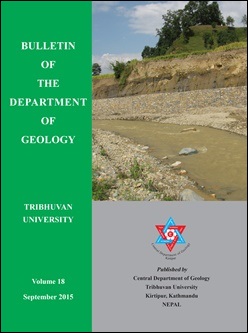Qualitative and quantitative assessment of gravel deposits between Aaptar and Malekhu, Central Nepal for aggregates
DOI:
https://doi.org/10.3126/bdg.v18i0.16456Keywords:
Aggregates, Los Angeles Abrasion Value, Aggregate Crushing Value, Aggregate Impact ValueAbstract
The Malekhu Khola is rich in sediments which are widely exposed along its banks. In recent years, river mining sites have been established and mining has been carried on to produce aggregates to meet a small portion of the market demand. Because the riverbank deposits are of heterogeneous composition, quality of the aggregate from such deposits is of main issue. This study therefore, aims to evaluate quality of river sediment to know its suitability for aggregate as raw material for various uses, and the volume of the deposit. Field observation and intensive laboratory works were carried out to evaluate aggregates. The samples of aggregates were analyzed for texture, composition, durability and physical and mechanical properties. Majority of the aggregate particles were found metamorphic rocks of the Lesser Himalaya like quartzite, schist, marble, metasandstone, amphibolites, gneiss and granite, etc. Most of the deposits were matrix-supported and the matrix was basically sandy. The majority of clasts showed bladed to disc, and were generally rounded to sub rounded. The sediment size ranged from granule to upto boulder but the modal size was of cobble grade. While tested for gradation, the coarse aggregates ranged from uniform to gap graded categories. In terms of shape, workability of aggregate was found satisfactory. Aggregate samples possessed low Water Absorption Value (0.53–1.08%) and thus low effective porosity. Aggregate Impact Value (13.40–15.70%) and Aggregate Crushing Value (17.50–19.67%) showed good soundness. Los Angeles Abrasion Value (37.00–48.40%) showed the consistent hardness of each of the samples. The low range of Sodium Sulphate Soundness Value (1.37–2.16%) indicated good resistance of aggregates against chemical weathering and frosting. The aggregates were also resistant to slaking as indicated by very high range of Slake Durability Strength Index (98.67–99.72%). Comparing with the existing Nepal Standard (NS), British Standard (BS) and American Standard of Testing Material (ASTM), the studied samples were suitable for concrete structures and unbound pavements. Six different localities were considered in the study area to estimate for resource of aggregates. The total volume of the deposits was estimated to be 392273 cubic meter.
Bulletin of the Department of Geology, Vol. 18, 2015, pp. 49-58
Downloads
Downloads
Published
How to Cite
Issue
Section
License
© Central Department of Geology, Tribhuvan University, Nepal

